
MAY CONTAIN NUTS

Search Shorpy
SHORPY ART

Framed or unframed, desk size to sofa size, printed by us in Arizona and Alabama since 2007. Explore now.
Join and Share
Ad-Free Shorpy
Shorpy is funded by you. Patreon contributors get an ad-free experience.
Learn more.

Recent comments
- Tobacco cam
- Basic fact I learned only later in life
- Put a Lid on it!
- Pinstripes in the Tower
- Sound enhancement
- 3438 in '38
- Second Career
- Their days are numbered
- Only the Sensor
- Train control mechanism
- Rarest of the Rare?? & Classy 3400 Class
- Control Mechanism
- Those standpipes
- Wrenches
- International D-40 I believe
- Job prospects
- You had me at Train
- Land of the free
- Broad-Exchange Bldg
- Parking innovation
- The old block
- "Peck turned a sweet propeller"
- National Bank Building
- Notch shot
- Straight ahead (right, left, left, right)
- Ship lifespans
- New service
- You Say Station, I Say Potato ...
- Iron Age
- Thank you, Cornelius Vanderbilt
Member Photos
The Shorpy
Printporium
Printporium
Search Shorpy
Search results -- 30 results per page
- Hauling the Nets: 1904
- Atlantic City, New Jersey, circa 1904. "Young's Pier. Hauling the nets." 8x10 inch dry ... in 1914 got swept away in a storm.
(The Gallery, Atlantic City, DPC, Sports) ... Posted by Dave - 08/20/2012 - 10:48am -
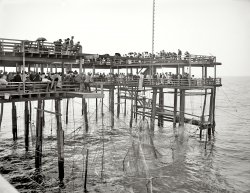
- Heinz 57: 1908
- The Jersey Shore circa 1908. "Atlantic City boardwalk and bathing beach." And on the far horizon, a familiar brand. ... Publishing Company. View full size.
(The Gallery, Atlantic City, DPC, Swimming) ... Posted by Dave - 07/29/2012 - 6:08pm -
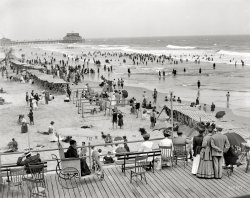
- AC: 1900
- The Jersey Shore circa 1900. "Atlantic City from lighthouse." View just to the left of the previous post. Detroit ... are very different now than in 1900.
(The Gallery, Atlantic City, DPC) ... Posted by Dave - 08/02/2012 - 3:17pm -
![AC: 1900 The Jersey Shore circa 1900. "Atlantic City from lighthouse." View just to the left of the previous post. Detroit Publishing Company glass negative. View full size.
Looks much better than todayI went for the first time a couple years ago, I would have rather had a time machine and gone back to 1900. That place is like a sewer now, I wouldn't go back even if you paid for everything.
Pretty neat old buildings here, though. What do you think they offer at the Capitol Sample Room?
GloomyThis photo reminds me of the first lines of Don Henley's song "Boys of Summer":
Nobody on the road,
Nobody on the beach.
I feel it in the air,
Summer's out of reach.
It would be interesting if some of the same shots were taken from the lighthouse during a warm afternoon on a summer weekend.
In the WaterThey seemed to have placed the utility poles below the tide line. Is that the way it was done elsewhere?
[Funny -- they built the pier that way, too. - Dave]
Hotel PierrepontThe $50,000 lobby. From an old postcard.
ProgressI don't know about the Jersey Shore being like a "sewer" but it certainly is an overbuilt nightmare now. People are living (or staying) on top of each other. This is a vacation? Not only the shore, but the people as well are very different now than in 1900.
(The Gallery, Atlantic City, DPC)](https://www.shorpy.com/files/images/4a05143a.thumbnail.jpg)
- Base-ball To-day: 1906
- The Jersey Shore circa 1906. "On the beach, Atlantic City." Note the DEFOREST WIRELESS station on the pier. Who wants ice cream? ... Posted by Dave - 08/13/2012 - 7:26pm -
![Base-ball To-day: 1906 The Jersey Shore circa 1906. "On the beach, Atlantic City." Note the DEFOREST WIRELESS station on the pier. Who wants ice cream? View full size.
Bet the ice cream was goodThose freezer buckets in the cart at right appear to be for 5-gallon ice cream cans. Large freezers like that are still available, complete with a belt wheel instead of a hand crank on the turning mechanism so a motor can do the work.
Weekend get-awayDo you think all those folks were there to get away from it all?
"Dry Ice"Must have been a necessity for those ice cream wagons, and surely it was available in 1906.
[Dry ice was not used commercially until the mid-1920s. -tterrace]
Question for the linguistsWhen did "base-ball" become "baseball"???
(The Gallery, Atlantic City, DPC, Horses, Swimming)](https://www.shorpy.com/files/images/SHORPY_4a27249a.thumbnail.jpg)
- Seaside House: 1907
- Atlantic City circa 1907. "Seaside Hotel (Seaside House)." Note the fly netting on the ...
[See the caption. - tterrace]
(The Gallery, Atlantic City, DPC, Horses) ... Posted by Dave - 05/10/2013 - 10:50am -
![Seaside House: 1907 Atlantic City circa 1907. "Seaside Hotel (Seaside House)." Note the fly netting on the horse. 8x10 inch glass negative, Detroit Publishing Co. View full size.
Times changeAnd not always for the best. This is where the Trump Taj Mahal now stands. By the 1950s it had become the Seaside Hotel and Motor Lodge, a 10 story brick hotel and a two level motel with a pool, and the area between the hotel and the boardwalk was a miniature golf course. We used to stay there for a week every September back in the 60s.
A Scorcher!I suspect this photo was taken on a very HOT day; both sets of ladies are using umbrellas, the carriages (which may have been taxi-like vehicles) are empty, and just about everyone else is in the shade of the porch.
Flies!Flies were epidemic at that time due to horse dung everywhere. Probably was miserable for the people by today's standards.
I have reservationsI look at this fine resort & think about the state of building codes and firefighting in 1907. I would opt for the downscale Hotel Jackson in the background. A lower floor, please.
What are theWhat are the string things hanging from the horse in the foreground?
[See the caption. - tterrace]
(The Gallery, Atlantic City, DPC, Horses)](https://www.shorpy.com/files/images/SHORPY_4a19470a.thumbnail.jpg)
- A Face in the Sand: 1906
- The Jersey Shore circa 1906. "Bathers at Atlantic City." Note the airship exhibit and roller rink on the pier. Detroit Publishing ... Posted by Dave - 05/17/2014 - 10:32pm -
![A Face in the Sand: 1906 The Jersey Shore circa 1906. "Bathers at Atlantic City." Note the airship exhibit and roller rink on the pier. Detroit Publishing glass negative. View full size.
Call the Kaiser!I think we found his missing zeppelin. What could that be on the roof?
[As noted in the caption, it's an airship exhibit. More speculation here. - Dave]
Indians?Sure looks like three, maybe four, tepees on the pier.
chair slingsI don't even know that this is the proper name for them, but we have a good look here at their backs & have seen them often on Shorpy. My question is, what were they? Did one rent a space in them? When did the disappear?
[They're similar to this, a folding patio chair/lounge (which are still made, though usually with a metal frame), but here on the beach are mounted semi-permanently. - tterrace]
BootyliciousIs that lady wearing a bustle under her bathing costume
Hey anybodyHas anybody even noticed the little black boy behind all the chairs, with his face to the sand?
No beach blankets!What continues to amaze me in all these turn of the century beach scenes is that everyone just sat on the sand. Nobody seems to have thought of bringing a towel or a blanket to spreadout and sit on. I guess they all went back to the bath house, showered, and changed into street clothes when they left, making it less necessary to keep the sand off.
[Doing laundry was much more of an ordeal back in pre-washing machine days, especially man-handling (or, in reality, woman-handling) a big water- and sand-logged towel. And even before that, lugging it all the way home on a train. Many of these folks even rented their bathing togs at the beach, so had nothing to take home but themselves. - tterrace]
Writing on the beach chair supportsDo Not Sit In Chairs With Wet Suits.
What About the Little Boy?Come on folks. What about the little boy with his face in the sand? He was the first person I noticed because he is completely alone. He probably isn't welcome on the main beach because he is black. This is one of the saddest, most heart-wreching photos I've seen on Shorpy.
(The Gallery, Atlantic City, DPC, Swimming)](https://www.shorpy.com/files/images/SHORPY_4a18707a.thumbnail.jpg)
- City of Ottawa: 1907
- Cleveland circa 1907. "Steamer City of Ottawa entering Cuyahoga Creek." 8x10 inch dry plate glass negative, ... 1945.
Launched on June 20, 1871 at Buffalo for the Atlantic, Duluth & Pacific Company by Gibson & Craig and the King Iron ... Posted by Dave - 01/22/2018 - 11:21pm -
![City of Ottawa: 1907 Cleveland circa 1907. "Steamer City of Ottawa entering Cuyahoga Creek." 8x10 inch dry plate glass negative, Detroit Publishing Company. View full size.
What is supporting that bridge?Was this photo somehow manipulated or am I just not seeing the bridge/ferry landing properly? The shadows do not look correct, nor does the water beneath it. Is the dark pile which is barely visible made of steel, and all that is bearing the weight?
[It's a swing bridge in the open position. -tterrace]
Thanks Dave...makes perfect sense now! I hadn't considered that it was pointing 90 degrees from its normal orientation :-) (even though I have a defunct center pivot one close by)
The Name GameCity of Ottawa had a pretty long life on the lakes, a nearly went further. Christened the INDIA in 1871, she joined sister ships in service known as CHINA and the JAPAN. From the annals of the Toronto Maritime Society, these were no run of the mill steamers plying the Great Lakes.
"...The passenger cabin of each was a veritable palace compared to other ships then operating. The staterooms opened off a long open passageway in which the dining tables were set at mealtimes. At the forward end of the cabin was the men's smoking room, while at the after end of the passenger area the cabin opened out into a spacious and luxuriously appointed ladies' cabin, complete with grand piano. The woodwork up to the level of the clerestory was varnished, while the deckhead was painted white. Woodcarvings were in evidence everywhere. The entire cabin was fitted with carpeting and an elegant companionway led down to the main deck where the purser's office was located. As usual for the period, bathroom facilities were not provided in the staterooms but each room did boast "running water" in that reservoirs mounted over the sinks were filled daily by the stewardesses and after that gravity did the rest. The galley was located on the main deck and the food (of excellent repute) was brought to the cabin by means of a primitive lift."
Ironically, while she went by City of Ottawa renaming for most of her sailing days, the ship started as INDIA and ended that way as well, while being refitted for saltwater use during WWII. She was sent down the Mississippi River to New Orleans but deemed too old and unfit, was eventually laid up along Lake Ponchartrain, where it's believed she meet her end to scrappers in 1945.
Launched on June 20, 1871 at Buffalofor the Atlantic, Duluth & Pacific Company by Gibson & Craig and the King Iron Works, the India was the first of a trio of state-of-the-art iron passenger and freight vessels running between Buffalo and Duluth, the others the China and Japan. Beginning the next year and for the next decade it ran for the Lake Superior Transit Company, allied with a pool of railroad-related steamship companies and after that with the Anchor Line, part of the Pennsylvania Rail Road. Sold in 1906 to the Montreal & Lake Erie Steamship Company, reflagged Canadian, repowered, and renamed the City of Ottawa, the vessel operated as the firm's name implies. Its passenger accommodations were removed in 1913 when Canada Steamship Lines Ltd. acquired the vessel and placed it in the package freight trade between Hamilton and Montreal. Laid up in 1926, the City of Ottawa was sold back into American registry briefly in 1928 and renamed India, and the next year back into Canadian registry for the Algoma Central Railway Company and renamed Sault Ste. Marie, running between Fort William and Toronto. In 1930 it again entered American registry and reverted again to the name India, cut down to a coal barge. Requisitioned by the Maritime Commission for war service in 1942, the India was brought down the Chicago River, Sanitary and Ship Canal, and the Illinois and Mississippi Rivers for a conversion that never occurred. The India was dismantled on the shore of Lake Pontchartrain in 1945.
The William L. Scott was built at Buffalo in 1890 by the Union Dry Dock Company for that city's Hand & Johnson Tug Line. It was abandoned and dismantled in 1915, probably at Erie, Pennsylvania.
Swing bridge?Never was a real fan of bridges that move. Really like them sitting still and anchored.
Getting A LiftFor fans and non-fans of moving bridges, the current edition at or near that same spot is a rather impressive rail lift bridge, rather than swing version. Everything's up to date in Cleveland.
Tugging at your heartThe tug WILLIAM L. SCOTT, built in 1890, was steam powered and of wood construction, weighing 54 gross tons, with dimensions of 67.9 x 17.4 x 10 feet. It was dismantled in 1915 at Union Dry Dock, Buffalo Shipbuilding.
I suspect the boat may have been named for Pennsylvania congressman William Lawrence Scott (1828-1891).
(The Gallery, Boats & Bridges, DPC)](https://www.shorpy.com/files/images/SHORPY-4a25406a.thumbnail.jpg)
- Pony Boys: 1905
- ... The Jersey Shore circa 1905. "Ponies on the beach -- Atlantic City." In the distance, the Steeplechase and Steel piers. 8x10 glass negative. ... Posted by Dave - 08/13/2012 - 6:56pm -
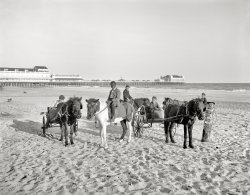
- Thirteen Ball: 1918
- ... reports:
For service in embarkation centers on the Atlantic seaboard, the Bureau of Construction planned and erected special huts. ... could be served. Two of these huts were built in New York City and were known as the Eagle and Victory Huts. In Washington, D.C. the ... Posted by Dave - 08/23/2012 - 5:32pm -
![Thirteen Ball: 1918 Washington, D.C., 1918. "Liberty Hut, Y.M.C.A." (W.W.H.D.?) Harris & Ewing Collection glass negative, Library of Congress. View full size.
No, No, not that oneLine up on the cue ball, Dufus. It is the white one with no numbers.
RookieHe must be new at this game. Somebody show him where the cue ball is.
Cold!My goodness, that looks cold. Several of the boys have their overcoats on. That hall ("liberty hut?") looks mighty drafty with that high ceiling.
The HustlerNotice the young man is aiming his stick directly at the numbered ball, instead of the cue ball. Either he's trying to hustle someone, or it was simply for the photo op.
One amongst manylady behind the desk.
Waiting timeI wish the Army would fork out for a second table.
Four StarsAnybody know the significance of the flag?
Lining UpA less snarky explanation is that he is gauging the angle to the distant corner pocket nearest the camera. One of the corner pockets nearest to him appears to be blocked by the 8 ball. Tough shot to make. I don't think such an obvious goof would pass without some of the guys in the back giggling.
ScandalousNot a single naked prince anywhere in sight!
Wartime YThe flag looks like a very large version of a service flag, given to those who had children serving in the war.
Is it possible that the flag refers to those who were lost or serving in the war that had a type of membership in this club/liberty hall?
Devil Dogs among the DoughboysI count at least 3 Marines in the crowd. How do I know? Details, details, details are the keys to all Shorpy photos.
Young Blue EyesLooks like a very young Frank Sinatra is watching the game, granted his eyes seem to be brown here...
From Tabernacle to HutWe've seen this building before, from the outside - the YMCA's Service with Fighting Men: An Account of the Work of the Young Men's Christian Associations in the World War (1922) reports:
For service in embarkation centers on the Atlantic seaboard, the Bureau of Construction planned and erected special huts. The largest was at Hoboken and was known as the Hudson Hut.
Buildings of a similar nature were built in other cities near the embarkation camps. These huts were of the same type of construction as those in camps and cantonments, but had in addition a cafeteria where meals and light lunches could be served. Two of these huts were built in New York City and were known as the Eagle and Victory Huts. In Washington, D.C. the YMCA took over the Billy Sunday Tabernacle, and modified it to serve as a dormitory with auditorium, billiard room, reading and writing rooms attached. After being remodeled it was christened the Victory Hut.
Thousands of soldiers passed through nearby Union Station en route to embarkation points during the war.
Hully Geet!
Washington Post, July 14, 1918.
Largest “Y” Hut Here
Former Sunday Tabernacle Doing Great Service for Soldiers.
“Hully Geet. This is a regular place with sheets and pillows.”
So one soldier exclaimed after he had been awakened from his sleep on a bench in Union Station and showed the way to Liberty Hut, just across the station plaza.
Not only a bed, sheets and pillows awaited him there, but a shower bath, a place to check his baggage, reading and writing rooms, music of pianos and Victrolas, companionship, and food, at a nominal cost.
It is a “regular” place all right, but a most extraordinary place as well. It is the largest Y.M.C.A. hut in the world and expert association men have studied huts in various camps to make its appointments a model for meeting the soldiers needs.
From now on Liberty Hut will be open 24 hours a day. From Midnight until 4 a.m. a secretary will patrol Union Station to invite any man in uniform who has no shelter in view to avail himself of the hut's hospitality.
For 35 cents the visitor receives the following:
Free checking of valuables and clothing.
Towel and soap and shower bath.
Baggage checked.
A Bed upon which the linen is changed daily.
Special rates at the Y.W.C.A. cafeteria adjoining.
If he hasn't the 35 cents the cost is nothing. No man in uniform will ever be turned away from the hut's doors.
Upon entering the soldier, sailor or marine is in the spacious lobby, in which there is a secretarial desk and three pool tables, a Victorola and a piano. To his right is a library, with a homelikeness that already has struck responsive chords in many a weary, dusty, train-tired man in uniform. There are shaded library lights, not the unbroken glare of electric bulbs, more musical instruments, books and magazines, curtained windows, more than half a hundred arm chairs, and inviting tables. …
Hully Gee!Without the 't', this seems to be the exclamation of choice in Kansas and Missouri, based on Google searching.
It apparently was a favorite of Teddy Roosevelt, too (in a telegram):
"In commenting on pictures I never use any language as modern as Latin. On the occasion in question my quotations were from cuneiform script, and the particular sentence referred to was the pre-Ninevite phrase “hully gee.”"
It also appears in an article in The Southeast Missourian - Sep 3, 1949:
Re: Hully GeeI wonder if it is clean-language euphemism akin to "gosh darn." Hully Gee(t) doesn't sound all that different from drawling, "Hœly shēēt."
[Most references I've found say it's "Holy Jesus!" - tterrace]
(The Gallery, Harris + Ewing, Sports, WWI)](https://www.shorpy.com/files/images/SHORPY_13988a.thumbnail.jpg)
- All You Can Drink: 1908
- The Jersey Shore circa 1908. "On the Boardwalk, Atlantic City." Advertising signage competes for our attention in this view -- Saratoga ... Posted by Dave - 09/05/2013 - 9:54am -
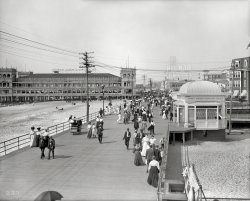
- A.C. Pier: 1904
- The Jersey Shore in 1904. "Pier at the inlet, Atlantic City." 8x10 inch dry plate glass negative, Detroit Publishing Company. View ... Posted by Dave - 06/16/2014 - 10:01am -
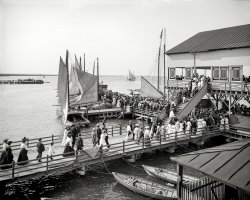
- Automobilists Welcome: 1910
- ... you look behind you, Lexington still disappears into the Atlantic Ocean.
Hesperus Avenue Named, I believe, after the Longfellow ... "Gloster"
The word "cester" is the Roman name for city or town. Hence many English named towns end in cester. Man , Wor, etc.
... Posted by Dave - 03/03/2023 - 3:51pm -
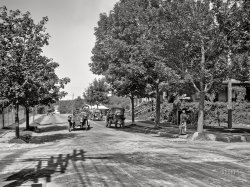
- Bridges of Pittsburgh: 1905
- ... that could" do its duty.
Topography underneath the city What I love about this shot is you can see the topography that lies ... note is the combination and coach in the yard near the Atlantic (4-4-2) locomotive. Though more than likely they are currently in ... Posted by Dave - 07/28/2012 - 4:55pm -
![Bridges of Pittsburgh: 1905 Circa 1905. "Pittsburgh from Mount Washington -- Monongahela River with Smithfield Street Bridge and Pan Handle Bridge." Panorama made from two 8x10 inch dry plate glass negatives. Detroit Publishing Company. View full size.
Little engine that couldThe steam locomotive bottom left has me wondering. Upon magnification it appears to be numbered 301, but can't quite make out the number, railroad initials or wheel arrangement. If this is the Monongahela Railroad the initials could be PRR or P&LE. They did acquire two class D-3 locos in 1904 and 1905 with a 4-4-0 wheel arrangement AND they were numbered 301 and 302. Then there was a 2-8-0 arrangement purchased in 1903 if the number is 201. Oh well, regardless of identity it certainly looks like an "engine that could" do its duty.
Topography underneath the cityWhat I love about this shot is you can see the topography that lies beneath all the buildings of Pittsburgh today.
The HillGreat shot of the East side of the city. Long before Boulevard Of The Allies and the Parkway took over the landscape. Those barren hills to the North are now home of Pittsburgh University. And there's a great bike trail where those rail cars and the mill once sat. This is all less than a mile from my place. I never get tired of looking at the old shots of this city and seeing how it has evolved into what it is today.
LOTS to LQQK at!!!That is just a totally awesome photo right there with lots and lots of stuff to look at. Just the railroad stuff (my favorite subject) can amuse one for hours. All those passenger and freight cars and rail served industries and in 1905 they probably kept track of where everything was and where it was going than they do now with computers, GPS tracking and less rolling stock and rail served industry!
In looking at the sky, though, one should be glad we DO have an EPA now. Of course, I suspect there may be just as many pollutants in the air now, it's just that we have cleaned them up so that you can't see them or smell them as well.
[Your suspicion is incorrect. The air here was much dirtier a century ago. - Dave]
I suspect you're right. --RJ--
Air QualityMeasured not in picograms per cubic liter, but in lbs. of cinder per cubic foot. Holy moley - that is dirty-ass air!
The little engineis a 4-4-2, presumably a P&LE class E-1 engine.
Jim CrowOf interesting note is the combination and coach in the yard near the Atlantic (4-4-2) locomotive. Though more than likely they are currently in storage, it's probable that the cars came off a train oriented like that. You saw that type of orientation quite often in the time of segregation, with black riders being placed in the section forward of the baggage compartment, and whites riding in the rest of the train. This gave rise to calling the orientation "Jim Crow." It would later be applied to special "Jim Crow" cars which had the baggage compartment in the middle of the car and passengers on either end.
(Panoramas, Boats & Bridges, DPC, Pittsburgh, Railroads)](https://www.shorpy.com/files/images/SHORPY_Pittsburgh_Panorama.thumbnail.jpg)
- Carnival of Fire: 1905
- Atlantic City circa 1905. "Hotel Chalfonte and Boardwalk." Where the diversions include ... for a strenuous stroll on the boardwalk!
(The Gallery, Atlantic City, DPC) ... Posted by Dave - 03/06/2014 - 10:27am -
![Carnival of Fire: 1905 Atlantic City circa 1905. "Hotel Chalfonte and Boardwalk." Where the diversions include shooting flames, rolling chairs and "social drama." 8x10 inch dry plate glass negative, Detroit Publishing Company. View full size.
What could possibly be the job description of the operator of those vehicles?
[Chairman of the Boardwalk. - Dave]
All the newsI swear that the wind blew a newspaper onto the face of the women in the first sedan chair the INSTANT the photo was taken - Hilarious!
[That's the veil of her hat. -tterrace]
The Strenuous LifeNice to see Colonel Roosevelt (right there behind the girl in white) out for a strenuous stroll on the boardwalk!
(The Gallery, Atlantic City, DPC)](https://www.shorpy.com/files/images/SHORPY_4a17669a.thumbnail.jpg)
- Sand Castles: 1905
- ... The Jersey Shore circa 1905. "Marlborough-Blenheim Hotel, Atlantic City." 8x10 inch dry plate glass negative, Detroit Publishing Company. View ... Posted by Dave - 03/03/2013 - 1:00pm -
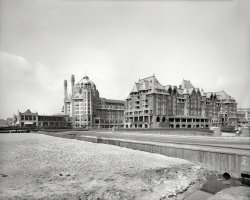
- Time and Tide: 1915
- The Jersey Shore circa 1915. "Atlantic City bathers and Steel Pier." 5x7 inch dry plate glass negative, Detroit ... "bandage" is a splash. - tterrace]
(The Gallery, Atlantic City, DPC, Swimming) ... Posted by Dave - 01/05/2015 - 2:44pm -
![Time and Tide: 1915 The Jersey Shore circa 1915. "Atlantic City bathers and Steel Pier." 5x7 inch dry plate glass negative, Detroit Publishing Company. View full size.
Bathing suit evolutionI was surprised that this one wasn't sooner than 1920, because of the fact that the bathing suits still looked like 10-15 years earlier while, just a couple years later, they were wearing the wool sleeveless suits that exposed most of the thigh. I wonder if it was regional, in part, that the skimpier suits started farther south and worked their way farther north. A few of them in this photo have shorter sleeves, but most still look like they are wearing the lighter corsettes under them. The wool suits, scratchy as they sound, would have been quite liberating over all the layers and layers. I just had another thought, though. When they got wet, they would have made the girl smell like a wet sheep!
Walking Wounded?Three fellows caught my eye: one has a bandage on his left shoulder, one has a bandage on his right shin, the other looks to have put down his cane in the foc's'cle of the boat.
[Right-shin guy's "bandage" is a splash. - tterrace]
(The Gallery, Atlantic City, DPC, Swimming)](https://www.shorpy.com/files/images/SHORPY_4a27536a.thumbnail.jpg)
- Windsor Castle: 1906
- Atlantic City, New Jersey, circa 1906. "Hotel Windsor and Boardwalk." 8x10 inch dry ... in an old image folder on my hard drive.
(The Gallery, Atlantic City, DPC) ... Posted by Dave - 07/30/2012 - 4:34pm -
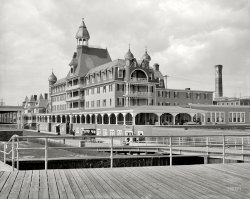
- Sea Water Baths: 1904
- ... The Jersey Shore in 1904. "Boardwalk at Green's Hotel, Atlantic City." 8x10 inch dry plate glass negative, Detroit Photographic Company. View ... Posted by Dave - 07/24/2018 - 11:40am -
![Sea Water Baths: 1904 The Jersey Shore in 1904. "Boardwalk at Green's Hotel, Atlantic City." 8x10 inch dry plate glass negative, Detroit Photographic Company. View full size.
Such Civility!My mom, born in 1920, instructed me at a very early age to always walk to the right-hand side be it a staircase, a sidewalk or a hallway. Everyone stays out of each other’s way and can enjoy the view without worry. No Mexican standoffs! Nowadays you’d think most young people were British the way they hog the left side -- very stressful.
"Do you know what fish do in that stuff?"Despite W.C. Fields' ostensible dislike of good old H2O, very early in his career he had a summer job as a "drowner" for various Jersey Shore hotels. He'd swim out beyond the surf line when there was a decent crowd on the boardwalk and very histrionically thrash about like a drowning man. With commensurate drama, a lifeguard or two would perform an exciting rescue, to the "ooohs" and applause of the tourists.
[Another version of that story can be found here. And yet another here. Both involving concession sales. - Dave]
Someone who claimed to have known Fields once told me that after one such performance, as the future comedian was being borne on a stretcher off the beach, he heard a woman remark, "My God, Mabel! That man must be a hopeless drunkard. It's the third time they've had to rescue him today."
Reflecting on W.C.'s distinctive features, it's clear that he was a poor choice to play a succession of non-descript victims. But he survived to conquer vaudeville, then talking pictures, and leave a legacy that persists until this day, so in a small way we have publicity-hungry Jersey hoteliers to thank for that.
Six years laterFrom a slightly different perspective, here's a view of the beach and the "Richard's Baths" in 1910, from a postcard in the New Jersey Almanac records.
Sun Baths at The PierAtlantic City "Sun Baths" Look closely for the sign.
(The Gallery, Atlantic City, DPC, Swimming)](https://www.shorpy.com/files/images/SHORPY-4a11551a.thumbnail.jpg)
- Marietta Street: 1864
- ... Broad I've spent hours poring over the 1871 Atlanta city directory , and it's clear to me that this picture was taken from the ... background being confused with the larger Western & Atlantic facility in the other direction. Today, the ground level is ... Posted by Dave - 08/09/2012 - 5:19pm -
![Marietta Street: 1864 1864. "Atlanta, Georgia. View on Marietta Street." Wet plate negative by George N. Barnard. LOC Civil War glass plate negative collection. View full size.
Purple HazeI wonder if one could buy a guitar at J C Hendrix ?
Wagon GhostAny idea what the white streak is?
[Like you say in the subject line, maybe a covered wagon passing by. - Dave]
What the building saidThe building across the street to the right says Furniture. What does the middle building say at the top? ["Franklin Printing House & Bookbindery" - Dave] Is there any way of telling what block of Marietta Street? And I would assume this picture was prior to the Nov. 11 fire.
November 11 fireThis photo must have been taken fairly close to that date, as the signs in the lower left corner advertise events (pantomimes are mentioned) taking place on November 8 and 10.
ExcitingTo take a peek back into history. I never take the wonder of photography for granted, and each and every picture is like a little piece of time saved.
Overhead AtlantaBelow is an aerial view of your photo -- the centre of a painting of 1864 Atlanta (presumably from sketches from a balloon) by Wilbur G.Kurtz. It appears in "Yesterday's Atlanta" by Franklin M.Garrett. Your photo is taken from right to left across the top of this bit of the painting. The big "car shed" is off to the left of the photo, which also seems to show a locomotive roundhouse at the end of the street, not shown in the photo.
That's not Marietta StreetIt's Alabama Street, facing east from the intersection of Whitehall.
[Any documentation to back this up? - Ken]
Marietta and BroadI've spent hours poring over the 1871 Atlanta city directory, and it's clear to me that this picture was taken from the corner of Marietta and Broad, with the photographer standing, elevated, on the opposite side of Marietta Street (which is not visible), and looking southwest down Broad Street toward Alabama Street. In the directory, you can find the Franklin Press (6 Broad), the S.B. Robson Broom company (Broad Street near Alabama), and the Grant Building (corner Broad and Marietta), which is home to many entities, including W.K. Fox Furniture. By 1871, J.C. Hendrix was an assistant secretary to the Georgia Senate; it appears that by that time, J.C. Hendrix & Co. no longer warranted an entry in the directory.
It's Alabama StreetI have mapped many of Barnard’s photographs on this interactive map. This picture is marked as Pushpin 7.
An earlier comment is correct; this is Alabama Street. Somewhere along the way it got mislabeled – probably due to the RR roundhouse in the background being confused with the larger Western & Atlantic facility in the other direction. Today, the ground level is Underground Atlanta.
(The Gallery, Atlanta, Civil War, Geo. Barnard)](https://www.shorpy.com/files/images/03462a.thumbnail.jpg)
- The Shelburne: 1910
- Atlantic City circa 1910. "The Boardwalk and Hotel Shelburne." 8x10 inch dry plate glass ... wooden hotels of the era - burning down.
(The Gallery, Atlantic City, DPC) ... Posted by Dave - 01/30/2020 - 12:25pm -
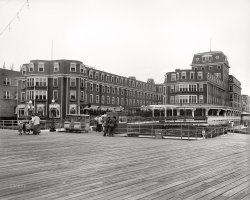
- Ferry Terminal: 1905
- ... Victor Talking Machine Co. Others rushed into trains to Atlantic City and suburban towns. Note the sign showing the brand-new electric trains. ... Posted by Dave - 08/14/2014 - 8:37am -
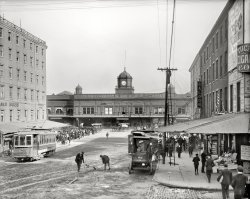
- So Many Summers Ago: 1905
- The Jersey Shore circa 1905. "On the beach at Atlantic City." Where's my pail? 8x10 inch dry plate glass negative, Detroit Publishing ... Posted by Dave - 08/26/2012 - 12:10pm -
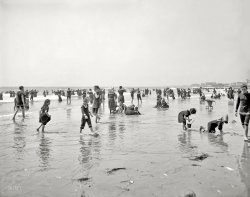
- Modern Kitchen: 1940
- ... Ocean rust When I finally got to visit the house of my Atlantic City great aunt, on S. Troy in Ventnor City, in 2000, I immediately noticed the ... Posted by Dave - 05/18/2013 - 7:29pm -
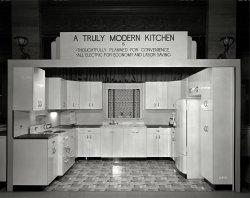
- Open All Year: 1901
- Circa 1901. "Hotel Islesworth, Atlantic City, N.J." 8x10 inch dry plate glass negative, Detroit Publishing Company. ... is a postcard of the Hotel circa 1910's
(The Gallery, Atlantic City, DPC) ... Posted by Dave - 04/07/2015 - 9:06am -
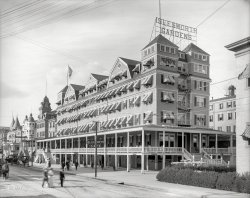
- Passing Lane: 1906
- ... Jersey shore circa 1906. "Rolling chairs on the Boardwalk, Atlantic City." Hotel Traymore in the background. 8x10 inch glass negative. View full ... Posted by Dave - 07/19/2012 - 12:56pm -
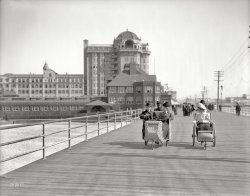
- The Garden: 1904
- Circa 1904. "Garden Hotel, Atlantic City." Sharing the corner with a high-tech arc lamp. 8x10 inch glass negative, ... telephone poles to the left are ace.
(The Gallery, Atlantic City, DPC) ... Posted by Dave - 08/21/2012 - 5:18pm -
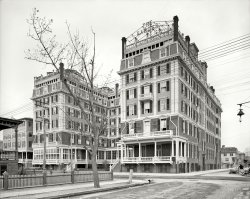
- The Chalfonte: 1913
- Atlantic City circa 1913. "Chalfonte Hotel." Here we are back at the beach, but with ... they are on the flag near the beach.
(The Gallery, Atlantic City, DPC, Swimming) ... Posted by Dave - 05/09/2013 - 10:23am -
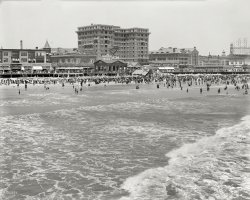
- The Dennis: 1908
- The Atlantic City Boardwalk circa 1908. "Hotel Dennis." And the Marlborough-Blenheim at ... including a Nosferatu imitator.
(The Gallery, Atlantic City, DPC) ... Posted by Dave - 09/21/2012 - 11:04am -
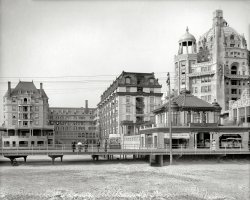
- Virginia Avenue: 1904
- Circa 1904. "Virginia Avenue -- Atlantic City, New Jersey." 8x10 inch dry plate glass negative, Detroit Publishing ... Definitely his stomping grounds.
(The Gallery, Atlantic City, DPC, Stores & Markets) ... Posted by Dave - 12/04/2013 - 10:37am -
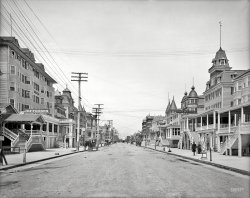
- Teasing: 1905
- Atlantic City circa 1905. "Teasing." One of a series of Detroit Publishing glass ... and peppers, and pizza over this stuff.
(The Gallery, Atlantic City, DPC, Swimming) ... Posted by Dave - 08/13/2012 - 7:26pm -
![Teasing: 1905 Atlantic City circa 1905. "Teasing." One of a series of Detroit Publishing glass negatives featuring these bathing beauties. View full size.
Aww, C'mon Emilyit's only a porpoise.
Blowing my mindAfter seeing so many beach scenes on Shorpy, I have come to expect the formality of early 20th century bathing attire but now I'm having a hard time comprehending the place of the shoes these ladies are wearing. Am I off in left field or did they really go in the water with those?
[While typical women's bathing garb of the period did include bathing shoes (see below), this photo and others in the series - in which these models are generally unshod - were not casual snapshots nor intended to be documentary. They're more in the nature of glamour shots, to be used in producing colored postcards or decorative prints, which was Detroit Publishing Company's business. - tterrace]
ZosteraOr eelgrass.
That's the stuff on this and almost every New Jersey beach following a storm. It grows in the shallow bays where it is habitat for many small marine aquatic creatures. I've seen tons of it floating in the low tide wave break of Barnegat Bay or just up on the bay beaches. When the tide receded it floats out to sea in huge rafts.
When it starts to rot while on the beach, it becomes a great habitat for flies.
I prefer remembering cheesesteaks, sausage and peppers, and pizza over this stuff.
(The Gallery, Atlantic City, DPC, Swimming)](https://www.shorpy.com/files/images/SHORPY_4a27420a1.thumbnail.jpg)























